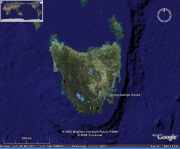Impacts of the Northern Pacific Seastar (Asterias amurensis) and European green crab (Carcinus maenas) on soft sediment assemblages in south east Tasmania
This study compared the individual and combined effects of two introduced marine species in SE Tasmania - the northern Pacific seastar (Asterias amurensis) and the European green crab (Carcinus maenas) - and investigated their impact on native invertebrate fauna using in situ caging experiments.
Both species predate upon bivalves, and this study assessed the biological interaction between these introduced species and native bivalve species - allowing the impact of multiple exotic predator species to be investigated in one system.
The cage experiments have 5 treatment groups, including all combinations of presence (single animal) and absence of seastars and crabs, and a control with neither. Predator activity (number and type of bivalves consumed) was recorded after 8 weeks by suction-sampling each cage and counting and identifying fauna.
Simple
Identification info
- Date (Creation)
- 2007-11-30T14:07:00
Principal investigator
Principal investigator
- Purpose
- To investigate the interactions and impact of two exotic marine species on native invertebrate fauna in SE Tasmania.
- Credit
- G.M. Ruiz
- Credit
- C.L. Hewitt
- Credit
- CSIRO Marine Research Centre for Research on Introduced Marine Pests
- Status
- Completed
Principal investigator
- Spatial representation type
- Text, table
- Topic category
-
- Biota
Extent
))
Temporal extent
- Time period
- 1997-01-01T15:43:00 1998-01-31T15:43:00
Vertical element
- Minimum value
- 2
- Maximum value
- 3
- Identifier
- EPSG::5715
- Name
- MSL depth
- Maintenance and update frequency
- Not planned
Resource format
- Title
- Excel
- Date
- Edition
- 2003
- CAAB - Codes for Australian Aquatic Biota v2.
-
- 25 154001
- Asterias amurensis
- 28 911009
- Carcinus maenas
- Global Change Master Directory (GCMD) Earth Science Keywords Version 8.0
- Keywords (Discipline)
-
- Temperate Reef
- Keywords (Theme)
-
- Shell length
Resource constraints
- Classification
- Unclassified
Resource constraints
- Use limitation
- The data described in the record are the intellectual property of the University of Tasmania through the Tasmanian Aquaculture and Fisheries Institute.
Resource constraints
- Linkage
-
http://i.creativecommons.org/l/by/2.5/au/88x31.png
License Graphic
- Title
- Creative Commons Attribution 2.5 Australia License
- Website
-
http://creativecommons.org/licenses/by/2.5/au/
License Text
- Other constraints
- The citation in a list of references is: citation author name/s (year metadata published), metadata title. Citation author organisation/s. File identifier and Data accessed at (add http link).
- Other constraints
- Please contact the researcher when accessing the dataset.
- Language
- English
- Character encoding
- UTF8
- Supplemental Information
- Ross, D.J., Johnson, C.R., Hewitt, C.L. and Ruiz, G.M. (2004). Interaction and impacts of two introduced species on a soft-sediment marine assemblage in SE Tasmania. Marine Biology 144: 747-756 DOI10.1007/s00227-003-1223-4 Ross, DJ. (2001). Impact of the northern Pacific seastar Asterias amurensis on soft sediment assemblages, including commercial species, in southeast Tasmania. PhD thesis. University of Tasmania.
Content Information
- Content type
- Physical measurement
- Description
- Abundance of sea stars
Identifier
- Code
- Abundance of biota
- Identifier
- http://vocab.nerc.ac.uk/collection/P06/current/UPMS
- Name
- Number per square metre
- Name
- Shell length
- Identifier
- http://vocab.nerc.ac.uk/collection/P06/current/UXMM
- Name
- Millimetres
Distribution Information
- Distribution format
-
- Excel
Distributor
- OnLine resource
- DATA - Main study data [direct download]
- OnLine resource
- DATA - length-frequency of green crab [direct download]
- OnLine resource
-
imas:TAF_DJRoss_Impacts_northern_pacific_seastar_european_green_crab_soft_sediment_GV
MAP - Sites of caging experiments
Resource lineage
- Statement
- Five treatment groups contained all combinations of presence (single animal) and absence of crabs and seastars in cages. There was also an unmanipulated plot (1m2) without cage or animals added. Cages were constructed of (1mx1 m base x 0.7m high) steel frame with legs (0.5m long) to anchor cage into sediment with 100-150mm of the cage side was buried. The cage top and sides were covered in plastic mesh (6mm). To control for patchiness of infauna in the analysis of treatment effects, we used a randomised complete-block design. The experiment ran for 8 weeks before cages and predators were removed. Two sampling techniques were used. Treatment plots were sampled with cores (150mm diameter, 100mm deep) to estimate abundance of infaunal and epifaunal organisms (>1mm). Three replicate cores were extracted at random positions for each plot. Samples were not taken within 0.1m of the cage perimeter to avoid edge effects. The entire contents of the plots were sampled to a 0.1m depth using a diver-operated air-driven suction device. To do this, an open square frame (1mx 1m) was inserted into the sediment to isolate the plot, and all contents vacuumed into a 1mm meshbag. Samples were sieved (1.0mm mesh) before fixing in 5-10% buffered formalin with Rose Bengal stain, and then rinsed in freshwater before storing in 100% ethanol. Infaunal and epifaunal organisms (>1mm) in core samples were sorted and identified to the lowest possible taxon. Suction samples were sieved again (2.0mm mesh), and all bivalves and the echinoid Echinocardium cordatum were sorted and identified to species. The number of clams (Fulvia tenuicostata and Katelysia rhytiphora) eaten by each predator was counted in suction samples. Undamaged, empty shells with gaping valves identified bivalves that were eaten by seastars. Bivalve hinges with only a fraction of the shell remaining were identified as prey eaten by crabs. The lengths of live and undamaged empty bivalves were measured in all treatments.
- Hierarchy level
- Dataset
- Hierarchy level
- Dataset
Platform
Identifier
- Code
- diver
Metadata
- Metadata identifier
- ce40ae30-9eef-11dc-a243-00188b4c0af8
- Language
- English
- Character encoding
- UTF8
Point of contact
Type of resource
- Resource scope
- Dataset
- Metadata linkage
-
https://metadata.imas.utas.edu.au/geonetwork/srv/eng/catalog.search#/metadata/ce40ae30-9eef-11dc-a243-00188b4c0af8
Point of truth URL of this metadata record
- Date info (Creation)
- 2020-08-14T11:53:53
- Date info (Revision)
- 2020-08-14T11:53:53
Metadata standard
- Title
- ISO 19115-3:2018
Overviews


Spatial extent
))
Provided by

 IMAS Metadata Catalogue
IMAS Metadata Catalogue